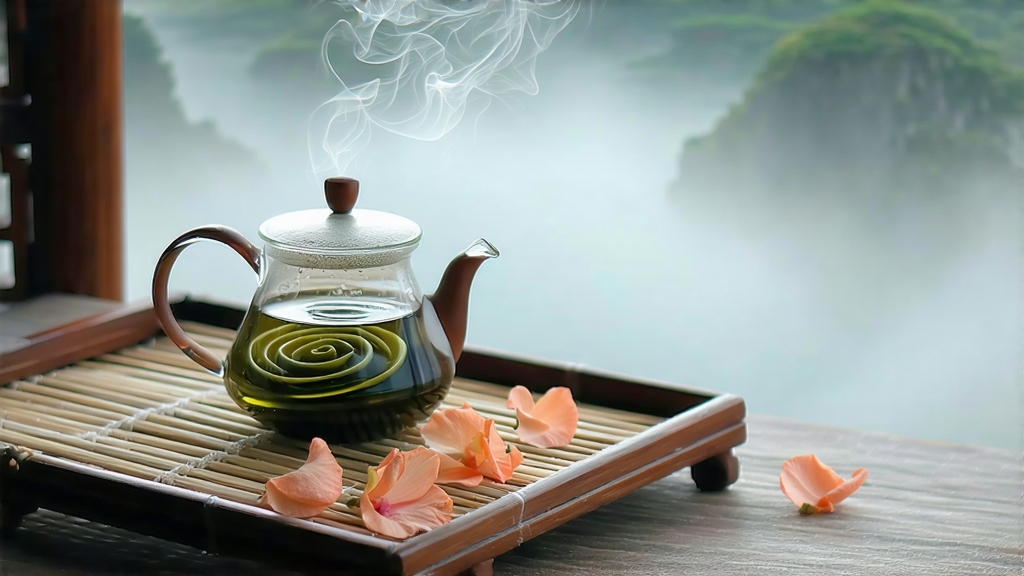
Few leaves in the world roll themselves into such tight, silken spirals as Biluochun, the “Green Snail Spring” that has captivated Chinese emperors and Parisian sommeliers alike. Produced only in a micro-zone around East Dongting Mountain on the vast freshwater Lake Tai, Biluochun is not merely a tea; it is a botanical chronicle of 1,200 years of horticultural obsession, imperial whim, and the alchemy that turns a single downy bud into a cup that smells of orchards at dawn. This essay invites the international reader to travel from Tang-dynasty tribute lists to twenty-first-century auction blocks, unpacking the leaf’s history, terroir, craftsmanship, and the quiet ritual that coaxes its famously elusive “peach and plum” aroma into fragrant reality.
-
Historical echoes in a single spiral
The first written record appears in the Tang Dynasty’s “Tea Canon” of 838 CE, where the leaf is called “Xia Sha Ren Xiang” (“Astounding Fragrance”) because a tea picker, her basket already full, tucked the tender shoots between her breasts; body heat released an intoxicating perfume that perfumed the entire mountainside. By the late Ming the name had morphed into “Biluochun,” referencing its snail-like curl and the green jade color that resembles the conch shells used in Buddhist ritual. The Kangxi Emperor (r. 1661-1722) visited Lake Tai twice, tasted the tea, and instantly declared it an imperial tribute, banning private sale and fixing the name in the dynastic annals. European merchants first encountered it in 1843 when the Suzhou guild presented a quarter-pound to the British consul in Shanghai; auctioned in London for the price of a small house, it became the benchmark against which all Chinese greens were judged. -
Terroir: where lake, mist, and fruit trees conspire
East Dongting Mountain is actually a peninsular range of weathered granite thrust into Lake Tai like a dragon’s tongue. The moderating water body creates a 3 °C smaller diurnal range than inland Jiangsu, while constant evaporation blankets the terraces in a humid veil that scatters sunlight into soft, diffuse photons. The soil is acidic (pH 4.8–5.2), rich in iron and manganese leached from pegmatite veins, and drains quickly thanks to 45° slopes. Most unusually, tea bushes here are interplanted with peach, plum, apricot, and loquat; the fruit trees bloom just as tea buds break, and their pollen drifts onto the damp leaf surfaces, contributing esters that later emerge in the cup as unmistakable stone-fruit top notes. No other Chinese green possesses this symbiotic orchard signature. -
Cultivar lineage: two bushes, one legend
Only two clonal selections are legally permitted to bear the name “Biluochun”:
• Dongting Small-Leaf #1 – compact bush, 0.8 m tall, 46 chromosomes, hypersensitive to temperature, yielding 320 kg fresh leaf per mu.
• Dongting Small-Leaf #2 – slightly larger, more cold-tolerant, prized for its higher linalool content (2.3 mg g⁻¹ versus 1.8 mg g⁻¹).
Both are propagated by single-node cuttings taken after the spring harvest, rooted under 75 % shade cloth, and transplanted when six months old at 30 cm spacing along contour hedgerows. Grafting onto generic Yunnan rootstock is forbidden under the Geographical Indication law enacted in 2002. -
The ten-hour metamorphosis: craft without shortcuts
Harvest begins when the overnight temperature stabilizes above 10 °C, usually between the Qingming festival and Grain Rain (5 April–20 April). Pickers—90 % women wearing bamboo hats—pluck only the “flag-and-bud” set: an unopened apical bud flanked by two cataphylls resembling miniature flags. The ideal leaf weighs 0.32 g and must reach the village workshop within 90 minutes; any longer and enzymatic oxidation dulls the jade color.
Withering is conducted not on bamboo trays but on 2 × 1 m silk screens stretched over braziers of charcoal derived from local peach wood. The temperature hovers at 28 °C for 45 minutes,